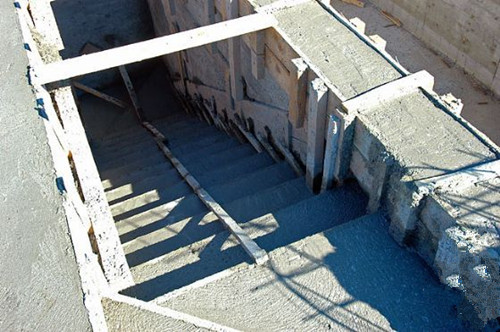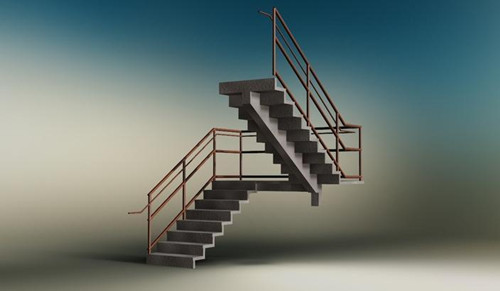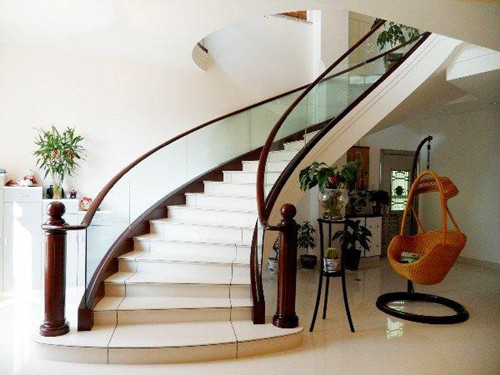In-situ concrete stairs , we may have seen in the renovation of the construction site, but its quality is unmatched by other materials. As the stairs are now mainly carrying a lot of weight, but also concerned about safety issues, to prevent fire, so cast-in-place concrete stairs are very popular. Some characteristics of cast-in-place concrete staircases may not be clear to many people. If you still have doubts about the in-situ concrete stairs, you may wish to follow me to learn more about it!

More fashionable stair shapes
Spiral staircase
Depending on the angle, the 180-degree spiral staircase is a stair-building method that can really save space. So most of today's building designs use such stairs. Regardless of whether the layout is narrow or wide, stair makers can make a variety of choices. The staircase with an area of ​​about 300cm×160cm is particularly stable and comfortable, and the appearance is very harmonious. Because of the particularly strong expressiveness of this construction method and the small footprint, the spiral staircase of the center column is also acceptable when the choice scope is limited. A friend of Dr. T’s type comment was suggested to use this paragraph.
Straight staircase
The length of the straight-lined stairway gap is not always as large as the stairway process. The important thing is that the "net height" of the passage should be at least 2m. Straight staircases require more space than spiral staircases, so if the design space for the stairs is large, straight stairs can be chosen.
Platform stairs
Although this kind of staircase is more space-consuming, it is loved by space enthusiasts. Stairs can either act as a space divider or they can be interconnected. In order to maintain harmony, the slope of the stairs should remain the same and the length of the steps should be the same.
Broken line stairs
The construction of such stairs has the advantages of good shape and space saving. The majority of turns occur at the entrance of the stairs, and may also be at the exit of the stairs. In addition, the walking rhythm of a staircase such as a zigzag spiral staircase is not exactly as straight as a staircase or a spiral staircase.
The other is the stairs in the attic. If you don't want ordinary extension ladders, but you want to be more comfortable, you can use this kind of chic and beautiful stairs, and you can put things in for a temporary use, especially in a small space.

Characteristics of cast-in-place concrete stairs
Due to load-bearing and fire prevention requirements, reinforced concrete stairs are generally used. This type of staircase can be divided into cast-in-place and assembly-type according to different construction methods. Among them, cast-in-place staircases have the advantages of flexible layout and easy to meet different architectural requirements, so they are widely used in construction projects.
Cast-in-situ concrete stairs, including straight stairs, curved stairs, etc. Calculated in horizontal projected area according to the dimensions of the design drawings, without deducting stairwells with a width of less than 500mm, the part projected into the wall is not counted; overall stairs (including straight Stairs, Curved Stairs) The flat projected area consists of resting platform, platform girder, inclined girder and staircase continuous girder; when the whole staircase is connected to the cast-in-situ slab without ladder beams, the 300mm boundary is added to the last step edge of the staircase.
1. Beam staircase
Typical example of a two-run beam staircase. The advantage is that when the bench is longer, it is more economic than the slab staircase, and the structure has less self weight. Therefore, it is widely used in office buildings, teaching buildings and other buildings; the disadvantage is that the template is more complicated and the construction is inconvenient. In addition, when the inclined beam is larger in size, At that time, the appearance was cumbersome.
The beam staircase consists of a tread plate, a diagonal beam, a platform plate and a platform beam. The tread plate is supported on the inclined beam, and the inclined beam is supported on the platform beam. Therefore, the load acting on the stairs is first transmitted to the inclined beam by the step board, and then transmitted to the platform beam by the inclined beam.
2, slab staircase
This staircase consists of a tread plate, a platform plate, and a platform beam. The load acting on the step board is directly transmitted to the platform beam. The tread plate is supported on the platform beams of the rest boards and floors. The rest plate rests on the rest plate platform beam.
The bottom surface of the slab staircase is flat, so the template is simple and the construction is convenient. The disadvantage is that the inclined slab is thicker.
Because of the large amount of concrete and steel used, the weight of the structure is relatively large, so it is generally used in cases where the span of the tread plate is less than 3 m. Due to the relatively lightweight and beautiful appearance of such stairs, staircases with large spans in some public buildings have also been widely used in recent years.
The template of the cast-in-situ concrete stairway is calculated by the horizontal projection area of ​​the exposed surface, and the area occupied by the stairwell less than 500 mm is not deducted. The side stencils of the stair treads, tread plates, and platform beams are not counted; the concrete of the cast-in-place concrete staircase is not deducted. To the outside of the staircase beam as a boundary, including stepping, inclined beams, rest platform, platform beams, connecting beams of stairs and floors, according to the actual volume calculation, the area occupied by the staircase wells should be deducted.

For modern interior architecture, the staircase is a product that has both functionality and brilliance. Based on the requirements of the architects and the owners, the shapes and designs are colorful. Spiral staircases are designed to save space. The stairs in the past are generally located in the front hall of the entrance, occupying a large area and costly. The stairs are now part of the living room. According to the stair makers, this is why the wooden staircases are enduring.
The new generation of stairs is more open and diverse in shape. Some of the traditionally inserted or mounted inclined beam staircases have been replaced by new stair structures. The steps of these new structures are often fixed directly to one end of the wall with a steel structure at the bottom and a vertical rod structure in the middle. Closed-structured staircases have almost disappeared from the market, and the preferred architectural style of the staircase is always in keeping with the comfortable living and popular architectural art. What kind of staircase is chosen under what circumstances depends entirely on the layout of the building.
Editor's summary: The above is about the knowledge of in-situ concrete stairs you know about how much knowledge, and hope to help friends who have this need! For more information, please continue to pay attention to our website, follow-up will show more exciting content.
Concrete stairs Cast-in-situ stairs Quotes Stairs How much money Continental decoration Stairs Duplex floor Stairs Renovation Cast-in-situ Concrete Stairs
Guangzhou Aiberry Pet Products Co., Lt , http://www.aiberrycn.com